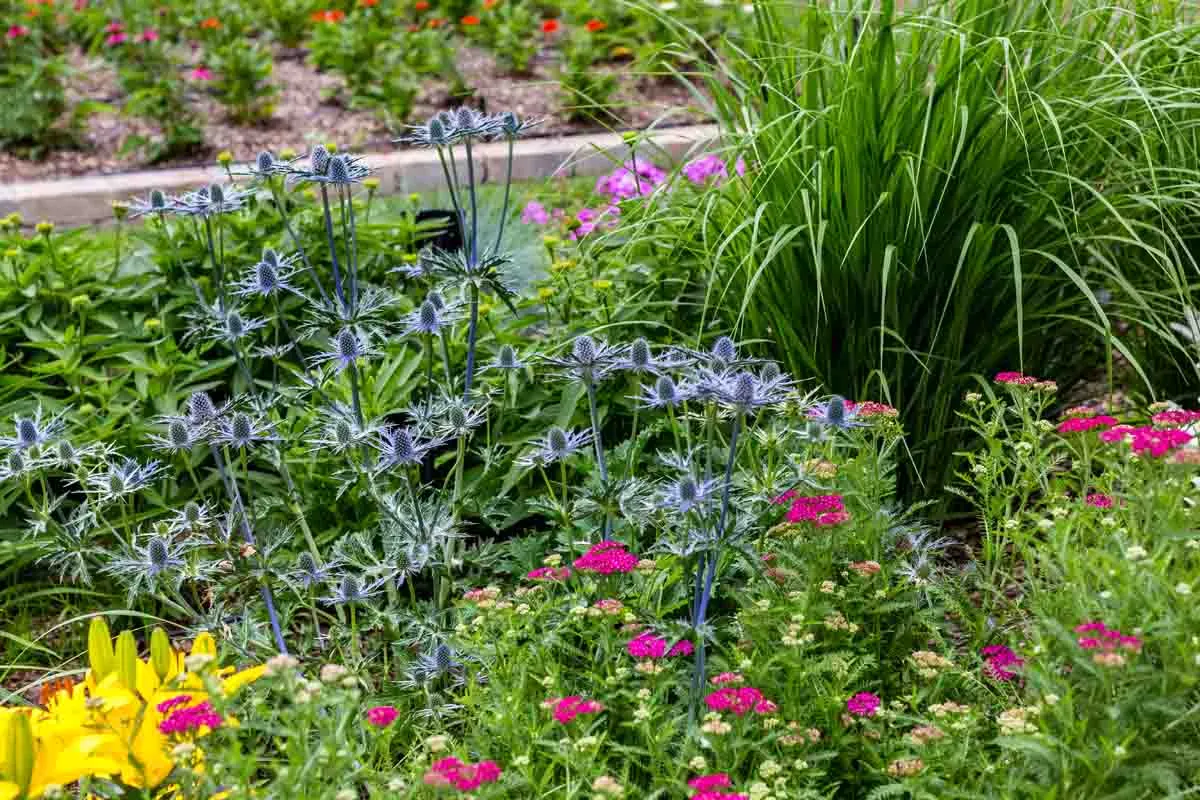Eryngium, commonly known as sea holly, is a captivating genus of flowering plants that has garnered attention and admiration from gardeners and horticulturists worldwide. With their striking metallic-blue flowers and unique architectural form, these plants bring a touch of the extraordinary to any garden setting. Beyond their aesthetic appeal, Eryngium species are also valued for their hardiness and ecological benefits, making them a versatile and sustainable choice for gardeners. This article delves into the fascinating world of Eryngium, exploring its characteristics, varieties, cultivation, and uses.
Characteristics of Eryngium
Eryngium belongs to the Apiaceous family, which also includes familiar plants like carrots and parsley. However, Eryngium’s appearance is far from ordinary. These plants are known for their spiky leaves and stems, which often have a silvery or bluish hue. The most eye-catching feature of Eryngium is its flowers, which are composed of small florets arranged in a dense, globular head surrounded by a ruff of spiny bracts. The overall effect is a thistle-like bloom that ranges in color from metallic blue to purple, and occasionally white or green.
Varieties of Eryngium
There are over 250 species of Eryngium, each with its unique characteristics. Here are a few notable varieties:
1. Eryngium planum (Flat Sea Holly): This species is prized for its profusion of small, steel-blue flowers that bloom from midsummer to early fall. It grows to a height of about 60-90 cm and is a favorite among pollinators.
2. Eryngium gigantean (Miss Willmott’s Ghost): Named after the Victorian horticulturist Ellen Willmott, who famously scattered its seeds in gardens she visited, this species boasts tall, spiky stems topped with large, silvery-white flower heads. It can reach up to 120 cm in height and adds a dramatic flair to garden borders.
3. Eryngium bourgatii (Mediterranean Sea Holly): This variety is known for its deeply divided, blue-green leaves with prominent white veins. The blue-purple flower heads are surrounded by spiny bracts, creating a striking contrast. It typically grows to about 45-60 cm tall.
4. Eryngium yuccifolium (Rattlesnake Master): Native to North America, this species features yucca-like leaves and round, greenish-white flower heads. It grows to a height of 60-150 cm and is well-suited to prairie-style plantings and naturalistic gardens.
Cultivation of Eryngium
Eryngium is relatively easy to grow, provided it is given the right conditions. Here are some key tips for successful cultivation:
1. Sunlight: Eryngium thrives in full sun. Ensure that the planting site receives at least six hours of direct sunlight daily to encourage robust growth and vibrant blooms.
2. Soil: Well-draining soil is essential for Eryngium. While these plants are tolerant of poor soil conditions, they dislike heavy, waterlogged soils. Adding gravel or sand to the planting site can improve drainage.
3. Watering: Once established, Eryngium is drought-tolerant and requires minimal watering. Overwatering can lead to root rot, so it’s best to allow the soil to dry out between watering’s.
4. Planting: Eryngium can be grown from seeds or nursery plants. When planting seeds, sow them in the fall or early spring. For nursery plants, spring is the ideal time for planting.
5. Maintenance: Eryngium is low-maintenance, requiring little more than occasional deadheading to promote continued blooming. Cutting back the stems after flowering can help maintain the plant’s shape and vigor.
Uses and Benefits of Eryngium
Eryngium’s unique appearance makes it a valuable addition to garden designs, providing architectural interest and texture. Here are some ways to utilize Eryngium in the garden:
1. Border Plantings: Eryngium’s spiky form and vibrant colors make it an excellent choice for borders, where it can add height and contrast to softer, more rounded plants.
2. Pollinator Gardens: Eryngium is highly attractive to bees, butterflies, and other pollinators, making it a great addition to pollinator-friendly gardens.
3. Dried Arrangements: The sturdy stems and long-lasting blooms of Eryngium make it ideal for dried flower arrangements. Simply cut the stems at their peak and hang them upside down in a cool, dry place.
4. Medicinal Uses: Historically, various species of Eryngium have been used in traditional medicine to treat ailments ranging from digestive issues to respiratory problems.
Conclusion
Eryngium, with its striking appearance and resilient nature, is a standout addition to any garden. Whether used to create dramatic borders, attract pollinators, or add interest to dried arrangements, this versatile plant offers a range of benefits for gardeners and the environment. Embracing Eryngium in your garden not only enhances its beauty but also contributes to a more sustainable and biodiverse ecosystem.
